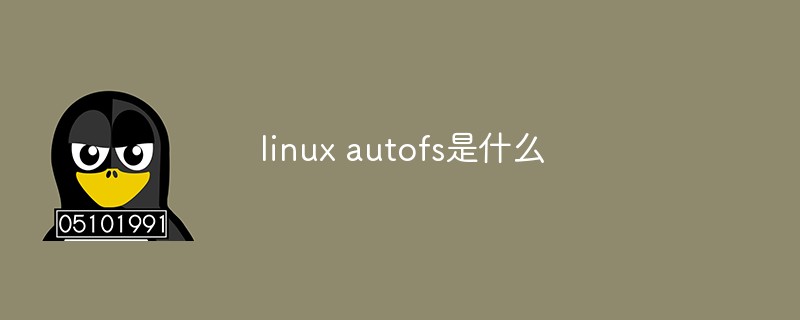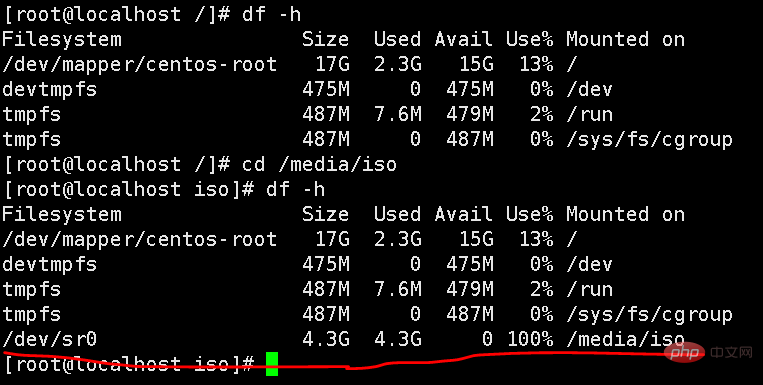what is linux autofs
autofs is a Linux system daemon that automatically mounts the file system when it detects that the user is trying to access a file system that has not yet been mounted. After filling the information into the /etc/fstab file, the system will automatically mount it every time it is powered on, while the autofs service program will be dynamically mounted when the user needs to use the file system, thereby saving network resources and The overhead of server hardware resources.

#The operating environment of this tutorial: linux7.3 system, Dell G3 computer.
1. Introduction to autofs service
When we use Linux, if we want to access hardware resources, we need to use the mount command to mount the hardware resources and correspond to a directory, and then we can Access the storage medium. If you use samba or NFS service, you also need to mount the remote storage device. Mounting is a necessary step when using external storage media or file systems. However, if too many resources are mounted, it will cause a certain load on network resources and server resources, thereby reducing server performance.
In order to solve this problem, we can use the autofs service. Autofs is a system daemon. We can write the mounting information into its configuration file. If the user does not access other storage media, the system No mounting will be performed. If the user attempts to access the storage medium, autofs will automatically perform the mounting operation. All the above operations are transparent to the user. In this way, the autofs service saves the server's network and hardware resources.
The autofs service program is a Linux system daemon process that automatically mounts the file system when it detects that the user is trying to access a file system that has not been mounted. After filling the information into the /etc/fstab file, the system will automatically mount it every time it is powered on, while the autofs service program will be dynamically mounted when the user needs to use the file system, thereby saving network resources and The overhead of server hardware resources.
Autofs is very convenient. There are two main points:
1) Set the directory that does not necessarily need to be mounted when booting. Implement automatic mounting.
2) If the user does not use the automatically mounted directory for a period of time, it will be automatically uninstalled. (The default time is 5 minutes)
2. Autofs installation and deployment
autofs can be installed using yum, the installation command is as follows:
yum install -y autofs
The main configuration file of the autofs service is /etc/auto.master. After opening, you need to write the format in the main configuration file:
Sub-configuration file of the destination mounting directory mounting directory
For example If we want to mount /dev/cdrom to the /mnt directory, we need to write the following content:

The red line is the newly written content.
Then create the /etc/cdrom.misc file and write the following content:
iso -fstype=iso9600,defaults :/dec/cdrom
Among them, iso represents the sub-mount directory under this directory. After completing all the above operations, start the autofs service, and sometimes The autofs service will be configured to start automatically. The autofs startup command is as follows:
systemctl start autofs
The autofs boot command is as follows:
systemctl enable autofs
3. Autofs effect verification
Next, let’s check the previous Verify the configured autofs effect. The verification idea is as follows: If it is not mounted, try to access the mounting directory to see whether the autofs system process is automatically mounted. The verification process is as follows:

It can be seen that the system does not originally mount /dev/cdrom, but when we access the /meida/iso directory, the system automatically The mount was performed, and obviously the autofs service ran successfully!
Related recommendations: "Linux Video Tutorial"
The above is the detailed content of what is linux autofs. For more information, please follow other related articles on the PHP Chinese website!

Hot AI Tools

Undresser.AI Undress
AI-powered app for creating realistic nude photos

AI Clothes Remover
Online AI tool for removing clothes from photos.

Undress AI Tool
Undress images for free

Clothoff.io
AI clothes remover

Video Face Swap
Swap faces in any video effortlessly with our completely free AI face swap tool!

Hot Article

Hot Tools

Notepad++7.3.1
Easy-to-use and free code editor

SublimeText3 Chinese version
Chinese version, very easy to use

Zend Studio 13.0.1
Powerful PHP integrated development environment

Dreamweaver CS6
Visual web development tools

SublimeText3 Mac version
God-level code editing software (SublimeText3)

Hot Topics
 What computer configuration is required for vscode
Apr 15, 2025 pm 09:48 PM
What computer configuration is required for vscode
Apr 15, 2025 pm 09:48 PM
VS Code system requirements: Operating system: Windows 10 and above, macOS 10.12 and above, Linux distribution processor: minimum 1.6 GHz, recommended 2.0 GHz and above memory: minimum 512 MB, recommended 4 GB and above storage space: minimum 250 MB, recommended 1 GB and above other requirements: stable network connection, Xorg/Wayland (Linux)
 Linux Architecture: Unveiling the 5 Basic Components
Apr 20, 2025 am 12:04 AM
Linux Architecture: Unveiling the 5 Basic Components
Apr 20, 2025 am 12:04 AM
The five basic components of the Linux system are: 1. Kernel, 2. System library, 3. System utilities, 4. Graphical user interface, 5. Applications. The kernel manages hardware resources, the system library provides precompiled functions, system utilities are used for system management, the GUI provides visual interaction, and applications use these components to implement functions.
 How to run java code in notepad
Apr 16, 2025 pm 07:39 PM
How to run java code in notepad
Apr 16, 2025 pm 07:39 PM
Although Notepad cannot run Java code directly, it can be achieved by using other tools: using the command line compiler (javac) to generate a bytecode file (filename.class). Use the Java interpreter (java) to interpret bytecode, execute the code, and output the result.
 vscode terminal usage tutorial
Apr 15, 2025 pm 10:09 PM
vscode terminal usage tutorial
Apr 15, 2025 pm 10:09 PM
vscode built-in terminal is a development tool that allows running commands and scripts within the editor to simplify the development process. How to use vscode terminal: Open the terminal with the shortcut key (Ctrl/Cmd). Enter a command or run the script. Use hotkeys (such as Ctrl L to clear the terminal). Change the working directory (such as the cd command). Advanced features include debug mode, automatic code snippet completion, and interactive command history.
 How to check the warehouse address of git
Apr 17, 2025 pm 01:54 PM
How to check the warehouse address of git
Apr 17, 2025 pm 01:54 PM
To view the Git repository address, perform the following steps: 1. Open the command line and navigate to the repository directory; 2. Run the "git remote -v" command; 3. View the repository name in the output and its corresponding address.
 vscode cannot install extension
Apr 15, 2025 pm 07:18 PM
vscode cannot install extension
Apr 15, 2025 pm 07:18 PM
The reasons for the installation of VS Code extensions may be: network instability, insufficient permissions, system compatibility issues, VS Code version is too old, antivirus software or firewall interference. By checking network connections, permissions, log files, updating VS Code, disabling security software, and restarting VS Code or computers, you can gradually troubleshoot and resolve issues.
 Where to write code in vscode
Apr 15, 2025 pm 09:54 PM
Where to write code in vscode
Apr 15, 2025 pm 09:54 PM
Writing code in Visual Studio Code (VSCode) is simple and easy to use. Just install VSCode, create a project, select a language, create a file, write code, save and run it. The advantages of VSCode include cross-platform, free and open source, powerful features, rich extensions, and lightweight and fast.
 Can vscode be used for mac
Apr 15, 2025 pm 07:36 PM
Can vscode be used for mac
Apr 15, 2025 pm 07:36 PM
VS Code is available on Mac. It has powerful extensions, Git integration, terminal and debugger, and also offers a wealth of setup options. However, for particularly large projects or highly professional development, VS Code may have performance or functional limitations.






